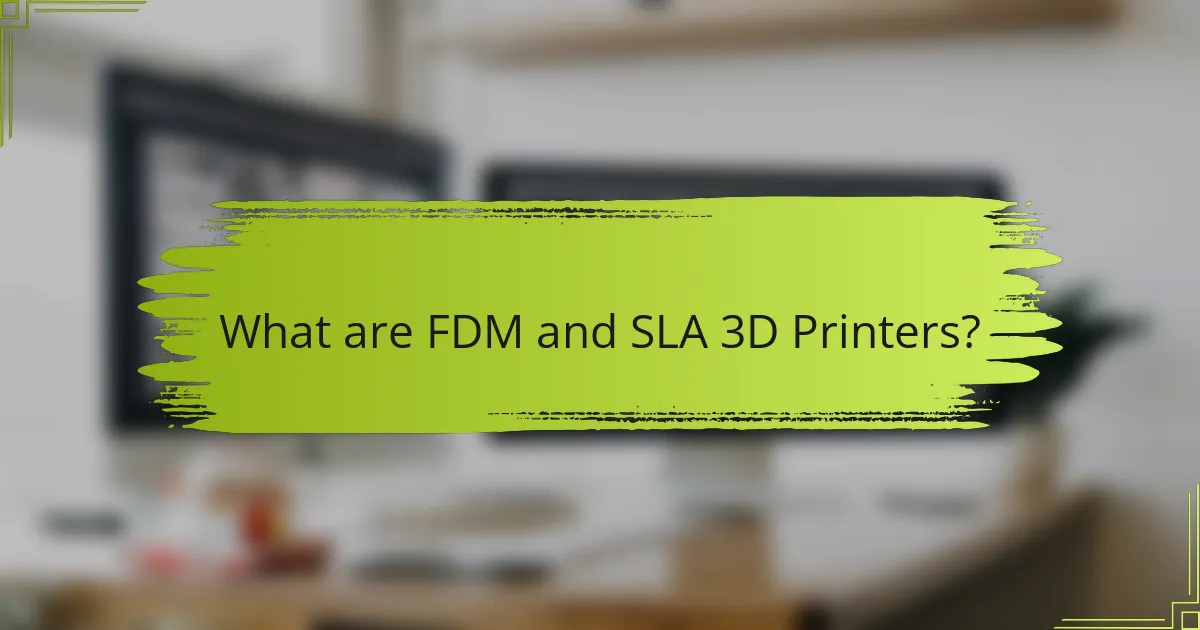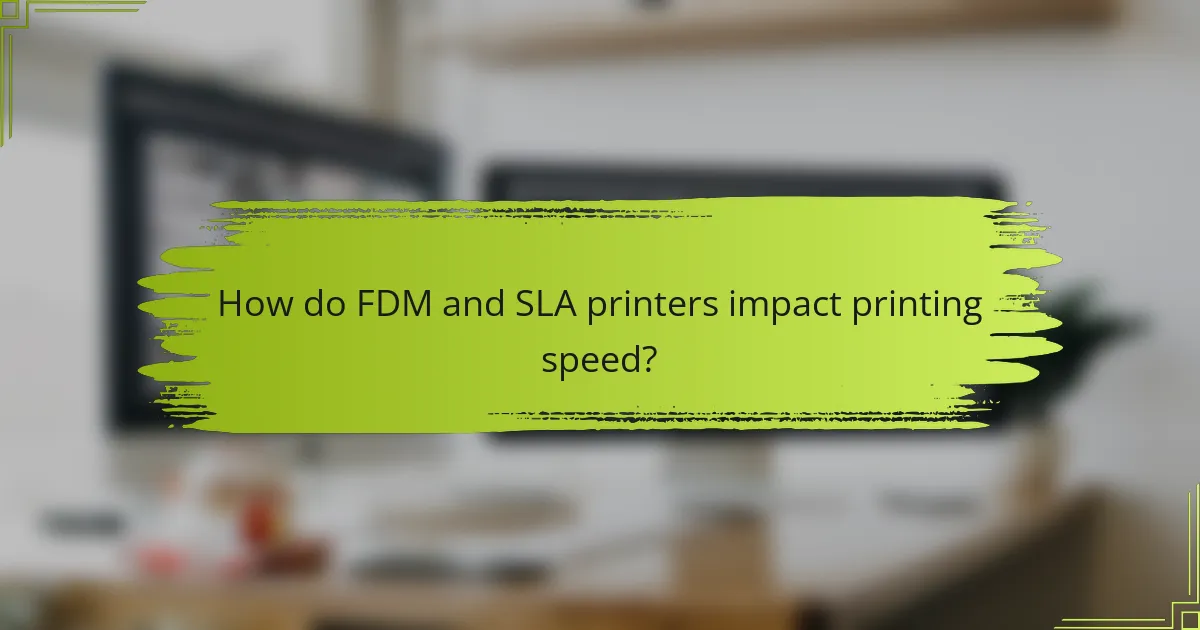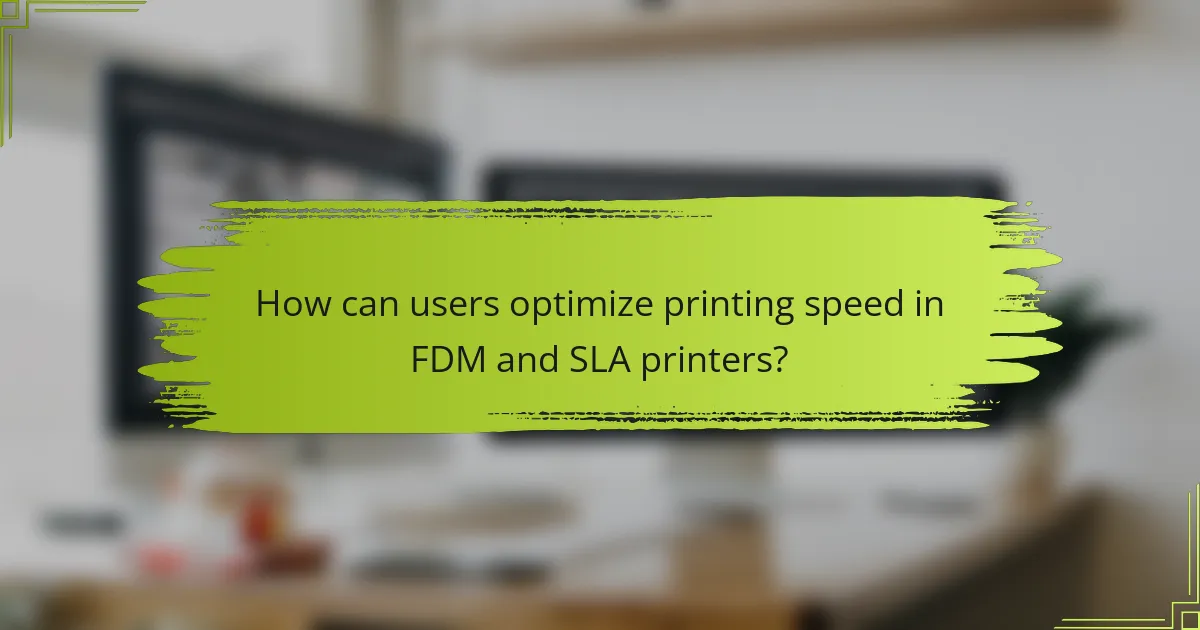
What are FDM and SLA 3D Printers?
FDM and SLA are two types of 3D printers. FDM stands for Fused Deposition Modeling. It uses thermoplastic filaments that are heated and extruded layer by layer to create objects. SLA stands for Stereolithography. It uses a laser to cure liquid resin into solid layers. FDM printers are generally faster and more cost-effective. SLA printers offer higher resolution and detail. Both technologies serve different applications in 3D printing. FDM is widely used for prototyping and functional parts. SLA is preferred for intricate designs and detailed models.
How do FDM and SLA technologies differ?
FDM and SLA technologies differ primarily in their printing processes. FDM, or Fused Deposition Modeling, uses thermoplastic filaments. These filaments are heated and extruded layer by layer to create a model. SLA, or Stereolithography, employs a liquid resin that is cured by a UV laser. This process solidifies the resin layer by layer to form a model.
FDM typically offers faster print speeds for larger models. It is well-suited for prototyping and functional parts. SLA provides higher resolution and detail for intricate designs. However, SLA prints are generally slower due to the curing process. The choice between FDM and SLA often depends on the required detail and speed for a specific project.
What are the key components of FDM printers?
FDM printers consist of several key components. The most important is the extruder, which melts and deposits filament. The hot end of the extruder reaches high temperatures to melt the material. The print bed provides a surface for the printed object and may be heated for better adhesion. The frame supports all components and maintains structural integrity during printing. Stepper motors control the movement of the print head and bed. The control board manages the printer’s operations and communicates with the software. Finally, the filament is the material used for printing, typically made of thermoplastics like PLA or ABS. Each of these components plays a critical role in the functionality and performance of FDM printers.
What are the key components of SLA printers?
The key components of SLA printers include a resin tank, a build platform, a light source, and a control system. The resin tank holds the liquid photopolymer resin used for printing. The build platform is where the object is formed layer by layer. A UV light source cures the resin, solidifying it according to the design. The control system manages the printing process, including layer exposure times and movements. These components work together to create precise 3D objects through the layer-by-layer curing of resin.
What are the advantages and disadvantages of FDM and SLA printers?
FDM printers have advantages such as lower cost and faster print speeds. They utilize thermoplastic filaments, making them accessible for various users. However, FDM prints often have lower resolution and surface finish quality. In contrast, SLA printers provide high detail and smooth surfaces due to their resin-based technology. Their disadvantages include higher costs and longer print times. Additionally, SLA materials can be more hazardous and require post-processing. Overall, FDM is cost-effective and quick, while SLA excels in precision and finish quality.
What are the benefits of using FDM printers?
FDM printers offer several benefits. They are cost-effective compared to other 3D printing technologies. FDM printers use thermoplastic filaments, which are widely available and affordable. The printing process is relatively fast, allowing for quicker prototyping. FDM printers are user-friendly and suitable for beginners. They require minimal maintenance and have a straightforward setup. The range of materials available includes various plastics with different properties. FDM prints can be produced in large sizes, making them versatile for various applications. These advantages make FDM printers popular in both hobbyist and professional settings.
What are the limitations of FDM printers?
FDM printers have several limitations. They often struggle with producing intricate details. This is due to the layer-by-layer construction method. The resolution is generally lower compared to other printing technologies. Warping and adhesion issues can occur during the cooling process. This affects the dimensional accuracy of prints. FDM materials can also be limited in strength and flexibility. Additionally, the range of printable materials is narrower than that of SLA printers. Lastly, FDM printers typically require post-processing to achieve a smooth finish.
What are the benefits of using SLA printers?
SLA printers offer high precision and detail in 3D printing. They use a laser to cure liquid resin layer by layer. This process allows for intricate designs that FDM printers struggle to achieve. SLA printers typically produce smoother surface finishes compared to FDM counterparts. They can create complex geometries with fine features, making them ideal for prototypes and detailed models. The printing speed of SLA printers can also be faster for certain designs due to their layer-by-layer curing method. Additionally, SLA materials often have better mechanical properties, enhancing the durability of printed objects.
What are the limitations of SLA printers?
SLA printers have several limitations. They typically have a slower printing speed compared to FDM printers. The resin used in SLA printing can be expensive, raising overall production costs. Additionally, SLA prints are often more fragile than those produced by FDM. The post-processing requirements for SLA prints can be labor-intensive and time-consuming. Furthermore, SLA printers require a well-ventilated area due to the fumes emitted by the resin. Lastly, the build volume is often smaller in SLA printers, limiting the size of printed objects.

How do FDM and SLA printers impact printing speed?
FDM printers generally offer faster printing speeds compared to SLA printers. FDM technology extrudes filament layer by layer, which can result in quicker build times. Typical FDM printing speeds range from 30 to 300 mm/s, depending on the printer and settings. In contrast, SLA printers use a laser to cure resin, which can limit speed due to the time required for each layer to solidify. SLA printing speeds often range from 10 to 100 mm/h, significantly slower than FDM. The difference in speed is influenced by the layer curing process in SLA, which is more complex and time-consuming. Therefore, for projects requiring faster turnaround, FDM printers are usually the preferred choice.
What factors influence the printing speed of FDM printers?
The printing speed of FDM printers is influenced by several key factors. These factors include nozzle size, layer height, print temperature, and print speed settings. A larger nozzle size allows for more filament to be extruded, increasing speed. Layer height affects the amount of material deposited per layer; thicker layers lead to faster prints. Print temperature impacts the flow of filament; optimal temperatures reduce extrusion issues. Additionally, adjusting the print speed settings in the slicer software can significantly alter the overall speed. Each of these factors interacts to determine the efficiency of the printing process.
How does layer height affect FDM printing speed?
Layer height significantly affects FDM printing speed. A smaller layer height increases the number of layers needed for a print. This results in longer print times. Conversely, a larger layer height reduces the number of layers. This leads to faster print completion. Research indicates that increasing layer height from 0.1 mm to 0.3 mm can reduce print time by up to 50%. Therefore, selecting an appropriate layer height is crucial for optimizing printing speed in FDM processes.
What role does nozzle size play in FDM printing speed?
Nozzle size significantly affects FDM printing speed. Larger nozzles can extrude more filament at once. This results in faster layer deposition. However, larger nozzles may reduce detail in intricate designs. Smaller nozzles provide finer detail but slow down the printing process. The trade-off between speed and detail is crucial in FDM printing. Studies indicate that increasing nozzle diameter can improve print speed by up to 30%. Therefore, selecting the appropriate nozzle size is essential for optimizing FDM printing speed while maintaining quality.
What factors influence the printing speed of SLA printers?
The printing speed of SLA printers is influenced by several factors. The layer height directly affects speed; thinner layers take longer to print than thicker ones. The exposure time for each layer also impacts speed; longer exposure times can improve detail but slow down the overall process. The movement speed of the build platform is another critical factor; faster movements can reduce printing time. The type of resin used can influence curing time, with some resins curing faster than others. Additionally, the printer’s hardware capabilities, such as the laser’s power and precision, can determine how quickly layers are formed. Finally, the design complexity of the printed object can affect speed; intricate designs may require more time to print accurately.
How does resin viscosity impact SLA printing speed?
Resin viscosity directly affects SLA printing speed. Higher viscosity resins flow more slowly, leading to longer layer curing times. This results in increased overall print time. Conversely, lower viscosity resins can be cured more quickly, reducing printing speed. Studies show that optimal viscosity ranges enhance print efficiency. For example, resins with a viscosity around 200-300 cP are often recommended for faster printing. Thus, managing resin viscosity is crucial for optimizing SLA printing speed.
What is the effect of layer exposure time on SLA printing speed?
Layer exposure time directly affects SLA printing speed. Longer exposure times increase the time needed to cure each layer. This can slow down the overall printing process. Conversely, shorter exposure times can reduce layer curing time. However, insufficient exposure may lead to incomplete curing. This can affect the quality and strength of the printed object. Studies indicate that optimal exposure times balance speed and print quality. For instance, a study by Chen et al. (2020) found that exposure times between 5 to 10 seconds yield optimal results.

How can users optimize printing speed in FDM and SLA printers?
Users can optimize printing speed in FDM and SLA printers by adjusting several key settings. For FDM printers, increasing the print speed setting in the slicer software directly affects the time taken for each layer. Additionally, using a larger nozzle size can enable faster extrusion of filament. Reducing the number of perimeters and infill density also decreases print time without significantly compromising strength.
For SLA printers, optimizing layer height can enhance speed. Thicker layers require fewer passes, thus speeding up the overall process. Users should also minimize the lift distance and speed during the peel phase to reduce the time spent on each layer.
In both cases, ensuring proper calibration of the printer can prevent errors that may lead to slower prints. Regular maintenance, such as cleaning the nozzle and ensuring the build platform is level, can also enhance printing efficiency. These adjustments can lead to significant time savings while maintaining print quality.
What strategies can enhance FDM printing speed?
Increasing FDM printing speed can be achieved through several strategies. First, adjusting the layer height can significantly reduce print time. A thicker layer height allows for faster deposition of material. Second, increasing print speed settings in the slicer software can improve overall speed. However, this may affect print quality. Third, optimizing infill patterns can reduce the amount of material used and speed up the process. For example, using a sparse infill can decrease print time without compromising strength. Fourth, using dual extrusion can enable faster printing of complex designs. This allows for simultaneous printing of different materials. Fifth, maintaining a well-calibrated printer ensures consistent performance and reduces failures that can slow down production. Lastly, selecting a high-flow nozzle can increase material flow rates, further enhancing speed. These strategies are supported by user experiences and technical guidelines from 3D printing communities.
How can print settings be adjusted for faster results in FDM?
To achieve faster results in FDM printing, adjust the print speed settings. Increasing the print speed can significantly reduce the time required for each layer. Set the nozzle temperature higher to ensure better flow of filament. Reduce the layer height to allow for quicker transitions between layers. Additionally, use a larger nozzle diameter to extrude more material at once. Optimize the infill density by lowering it to decrease print time. Lastly, consider disabling or reducing support structures when possible, as they can add to the overall print duration. These adjustments can collectively lead to faster FDM printing without compromising quality significantly.
What maintenance tips can improve FDM printing speed?
Regular maintenance can significantly improve FDM printing speed. First, ensure that the print bed is level. An uneven bed can cause print failures and slow down the process. Second, clean the nozzle frequently. Clogs can lead to under-extrusion and reduced speed. Third, lubricate moving parts. This reduces friction and allows for smoother operation. Fourth, check the filament quality. Poor quality filament can lead to inconsistent extrusion rates. Fifth, maintain proper temperature settings. Incorrect temperatures can affect flow rates and speed. Lastly, keep the printer free of dust and debris. A clean machine operates more efficiently and can increase print speed.
What strategies can enhance SLA printing speed?
To enhance SLA printing speed, optimize layer height and exposure time. Using a larger layer height reduces the number of layers required for a print. This adjustment can significantly decrease print duration. Additionally, increasing the exposure time per layer can improve adhesion and reduce the likelihood of print failure.
Adjusting the lift speed of the build platform also contributes to faster prints. A faster lift speed minimizes the time spent on the peel phase. Utilizing high-performance resin can further expedite the process, as certain resins cure faster than others.
Employing a printer with a larger build volume allows for more efficient use of time by printing multiple parts simultaneously. Regular maintenance of the printer, such as cleaning the resin vat and ensuring the light source is functioning optimally, also aids in maintaining speed.
These strategies collectively can lead to a more efficient SLA printing process, resulting in quicker turnaround times for 3D prints.
How can exposure settings be optimized for SLA printing?
Exposure settings for SLA printing can be optimized by adjusting exposure time and light intensity. Shorter exposure times can reduce layer curing, while longer times improve adhesion and detail. Light intensity affects the speed of curing; higher intensity can speed up the process. Testing various settings helps find the right balance for specific resin types. For example, resins often have recommended exposure times listed by manufacturers. Proper calibration ensures that prints maintain accuracy and surface quality. Consistent monitoring of exposure settings leads to improved print reliability.
What maintenance practices can improve SLA printing speed?
Regularly cleaning the resin vat improves SLA printing speed. Residue buildup can cause layer adhesion issues. Ensure the build plate is leveled correctly to enhance print accuracy. A misaligned build plate can lead to failed prints, slowing down the process. Updating firmware can optimize printer performance. Manufacturers often release updates that improve speed and reliability. Regularly checking and replacing worn parts, such as the FEP film, maintains print quality. A damaged film can cause delays and print failures. Finally, maintaining optimal resin temperature can reduce viscosity, aiding in faster layer curing.
What are common troubleshooting tips for improving printing speed?
To improve printing speed, users should optimize print settings. Reducing layer height can decrease print time. Increasing print speed settings in the slicer software also helps. Using a larger nozzle size allows for faster extrusion. Ensuring the printer is well-maintained prevents slowdowns. Checking for filament jams can improve flow and speed. Utilizing draft mode can speed up non-critical prints. Lastly, minimizing the number of support structures can enhance overall speed.
The main entity of this article is the comparison between FDM (Fused Deposition Modeling) and SLA (Stereolithography) 3D printers, focusing on their printing speeds and technologies. The article explores the fundamental differences in their printing processes, key components, advantages, and disadvantages. It also discusses factors that influence printing speed for both FDM and SLA printers, along with strategies for optimizing performance and troubleshooting common issues. By examining these aspects, the article provides a comprehensive overview of the capabilities and limitations of each printer type in various applications.